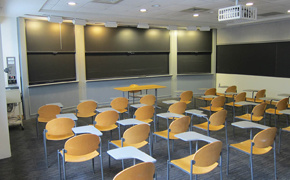Instructor Insights pages are part of the OCW Educator initiative, which seeks to enhance the value of OCW for educators.
Course Overview
This page focuses on the course 21H.134J Medieval Economic History in Comparative Perspective as it was taught by Professor Anne McCants in Spring 2012.
This course surveys the conditions of material life and changing social and economic conditions in medieval Europe with reference to the comparative context of contemporary Islamic, Chinese, and central Asian experiences. Beyond the content, this course is intended to help students think, problem solve, and communicate.
Course Outcomes
Course Goals for Students
- To hone their ability to think, problem solve, and make connections
- To develop their ability to fashion and communicate ideas
- To understand a world different from their own; to gain the perspective that their presumptions are a construction of the world that they grew up in and the experiences that they’ve had
- To think critically about the function and obligation of economies
- To learn to read texts
- To learn history and geography
Humanities classes help students fashion ideas, think critically, problem solve, make connections, understand different perspectives, and communicate.
— Prof. McCants
In the following pages, Prof. McCants describes various aspects of how she teaches 21H.134J Medieval Economic History in Comparative Perspective.
- Starting the Course with a Survey
- Teaching Students to Think, Problem Solve, and Make Connections
- Infusing the Course with Current Events and Articles
- Teaching Communication
- The Intersection of Research and Teaching
- Adapting the Course from Year to Year
- Beyond the Course: Related Workshops
Curriculum Information
Prerequisites
- None
Requirements Satisfied
- HASS-S

- CI-H

Offered
- Every spring semester unless Prof. McCants is on leave

Breakdown by Year
Primarily juniors and seniors; some sophomores; very few freshmen
Breakdown by Major
Primarily economics majors, minors, and concentrators
Typical Student Background
A lot of the students are economists and know Neoclassical economic theory pretty well. However, an economics background is not presumed and all economics concepts are explained before they’re used.
Most students enter the class with little knowledge of medieval history besides what they’ve gleaned from inaccurate movie portrayals. They learn background material in the course via storytelling, timelines, maps, and other material. According to Prof. McCants, “For a student who actually knows some medieval history, it might sound patronizing and annoying, but such students are so rare.”
During an average week, students were expected to spend 12 hours on the course, roughly divided as follows:
Lecture
- Met every Monday
- All students together
- Taught by Prof. McCants unless she was out of town
- A “chatty” lecture with lots of questions and answers from both the instructor and the students
- Interactive exercises, such as the start-of-term survey, board exercises, and other activities that got people standing up and moving around or writing
Recitation
- Met every Wednesday
- Students split into three recitation sections, each with about 15-20 students.
- Students were expected to complete their readings before recitation each week.
- Assignments were submitted, returned, and discussed during recitation sections.
Out of Class
Semester Breakdown
| WEEK | M | T | W | Th | F |
|---|---|---|---|---|---|
| 1 |  |  |  |  |  |
| 2 |  |  |  |  |  |
| 3 |  |  |  |  |  |
| 4 |  |  |  |  |  |
| 5 |  |  |  |  |  |
| 6 |  |  |  |  |  |
| 7 |  |  |  |  |  |
| 8 |  |  |  |  |  |
| 9 |  |  |  |  |  |
| 10 |  |  |  |  |  |
| 11 |  |  |  |  |  |
| 12 |  |  |  |  |  |
| 13 |  |  |  |  |  |
| 14 |  |  |  |  |  |
| 15 |  |  |  |  |  |
 No classes throughout MIT
No classes throughout MIT Lecture
Lecture Oral presentations for final paper
Oral presentations for final paper No class session scheduled
No class session scheduled Recitation
Recitation Assignment due date
Assignment due dateLead Instructor (Prof. Anne McCants - additional profile)
- Lead instructor; responsible for course development and organization
- Lectured every Monday unless she was out of town
- Led a recitation section on Wednesdays
Teaching Assistants (2) - typically a senior lecturer (Dr. Steven Ostrow) and a graduate student
- Fully led one recitation section each: taught the section, met with students, graded papers on their own terms. When there’s a first-time TA, the course staff meets to calibrate paper grading, but beyond that, Teaching Assistants have jurisdiction over their students’ papers.
- Sometimes helped out in the main lecture during interactive activities
- Attended every lecture and assisted when appropriate
- Taught the lecture section when Prof. McCants was out of town
Entire Teaching Team
Prof. McCants is a medievalist; one of the TAs is always a senior lecturer who is an ancient historian; and the third TA is typically a graduate student working in the 19th or 20th century. Collectively, their expertise spans a lot of history, allowing them to provide historical context, answer questions about other time periods when relevant, and interpret events and issues in different historical contexts.


 Room 1 of 2
Room 1 of 2 
